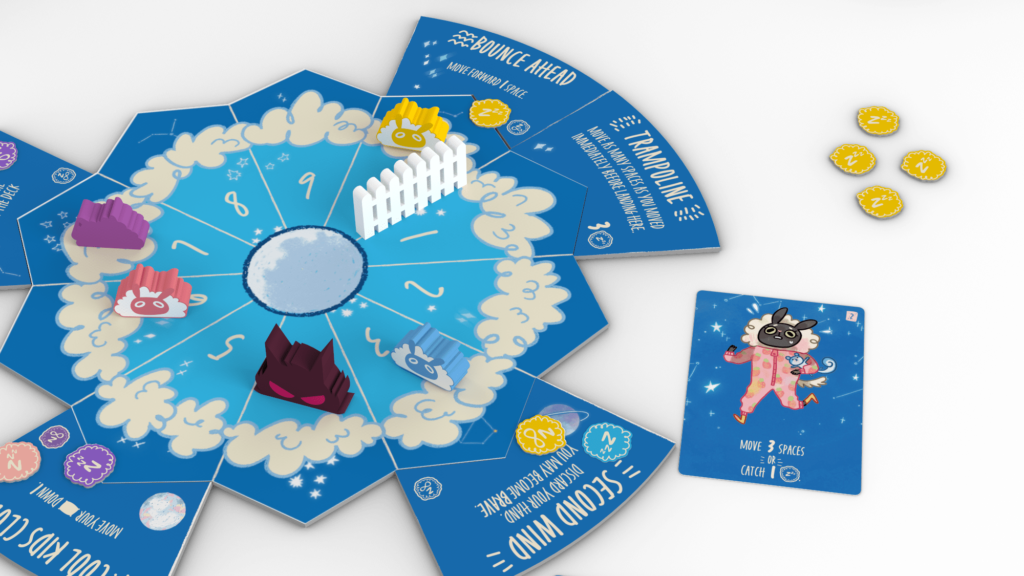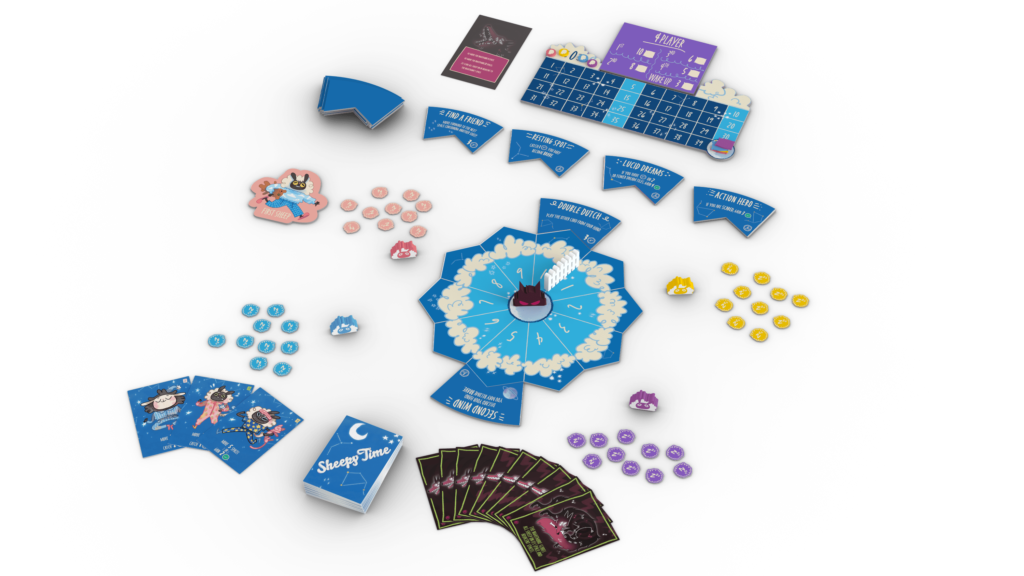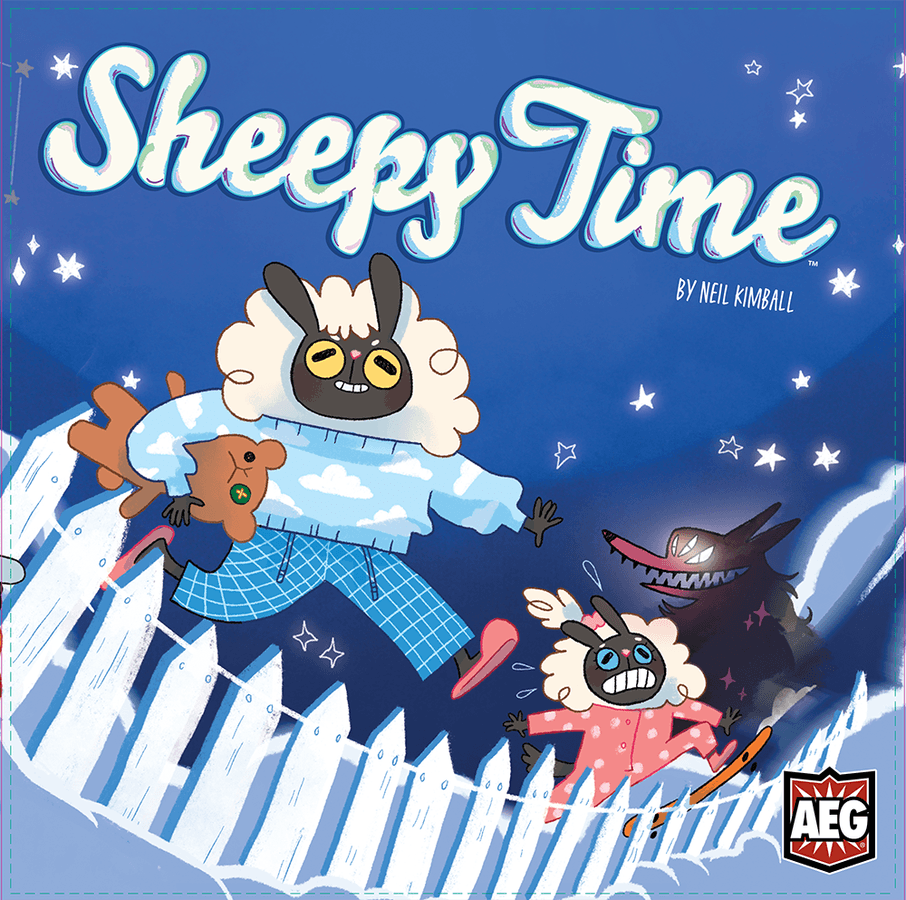Sheepy Time is the brainchild of designer Neil Kimball, and publishers Alderac. In it, you play a Dream Sheep, and these woolly critters are the same ones people count to fall asleep. Your goal, if ewe can believe it (sorry…), is to jump the fence enough time to send your person to the land of nod, without letting the nasty nightmares get to them first.
I’ve mentioned before that I’m a big fan of push-your-luck in games. If it’s used well, it creates so much drama and interaction around the game table, and Sheepy TIme uses it really well. One of my favourite games of recent years is The Quacks of Quedlinburg, because it balances risk and reward so nicely. Sheepy Time does something similar, but in a different way, and I think I might even prefer it.
Getting forty winks
Gameplay in Sheepy Time is really simple, and very easy to teach and learn. On your turn you play one of the two cards in your hand, and do one (or sometimes both) of the actions on it. These actions almost always allow you to move a certain number of spaces around the board, or to place your Zzz tokens on one of the Dream Tiles, but more on that in a bit.

Every time you move enough spaces to jump the fence, you claim the five Winks (victory points) then make the decision whether to keep going and try for one more lap, or to call it a night, and cash out with the points you’ve accumulated that round. If you’re wondering what your incentive is to call it a night, there’s a nightmare piece moving around the board too.
There are a number of nightmare cards shuffled into the draw deck, and every time one is drawn you immediately carry out the actions, which typically move them a number of spaces around. If the nightmare jumps the fence before you call it a night, you lose your points for that round. Knowing when to call it quits and when to push your luck, is a tricky choice to make. And that’s where the magic of Sheepy Time comes from.
In it together
As much as I enjoy Quacks, there’s a small issue that detracts from the experience for me. It’s a very insular game: you build your bag, pull your ingredients, make your potion. The only time you have to all look at the same place and come together mentally, is when you do the round-end scoring. Sheepy Time does something really nice in having one central board for all the players, and it turns the experience into a really communal one.

There’s a common enemy in the nightmare, and you’re all playing on the same board, with the same dream tiles, and the forced end of the round is the same for everyone. You can all see the scoreboard and see how close someone is to winning, and that adds some brilliant drama and tension. Knowing that you need one more hop of the fence to win, and that everyone else has already called it a night. Knowing that the nightmare has already scared you (meaning landing in the same space as it once more ends your round), and is only one space away from jumping the fence – that kind of tension is amazing.
Too excited to sleep
We’ve played games of Sheepy Time where it’s come down to the wire, and the sheer drama of every card draw, and seeing whether a nightmare card comes off the top of the deck – it’s palpable. Each draw is greeted with gasps of agony and relief. For the strategists among you, that might sound like a nightmare (oops), but if you enjoy a game that’s about the people around the table and the shared experience, it’s amazing.

To keep the game fresh there are the aforementioned Dream Tiles. After each round these can be added to the spaces around the board. If you land on one and have a Zzz tile on it, you can use its ability, such as moving extra spaces, moving the other sheep, or even getting a few extra points. Clever placement of them can even let you combo bonuses one after the other, which feels great.
There are three different nightmare opponents in the box, who all behave differently, and add some freshness if things ever feel stale.
Final thoughts
When I first saw Sheepy Time, I wasn’t particularly enthused. I’m guilty of thinking it looked like a simple kid-friendly game. I’m so glad I was given the chance to play it, and to give myself a kick up the backside to make sure I don’t fall foul to preconceptions. Zoé Plane’s artwork is simultaneously cute and creepy, and I hope I see her art in future games. It fits the theme so well.
My comparisons to The Quacks of Quedlinburg are valid in my opinion, as they both do push-your-luck so nicely. Sheepy Time just does it in a different way. Instead of the personal investment in your own little bag of ingredients in Quacks, you’ve got this shared board, this arena, where everyone can see what’s going on at all times, and everyone knows what they’ve got to do in order to win.
Just because it didn’t arrive with the same fanfare as a lot of games have this year, doesn’t detract from the game you’ll get for your ~£30. If your family or group enjoy balancing risk and reward, it’s a great choice. Even when you lose, the stories you tell afterwards about that time someone pipped you on the last turn of the game, are the same stories that’ll see you playing the game again and again. Sheepy Time is a sleeper hit, and I don’t really have a baaaaad word to say about it.
Review copy kindly provided by Alderac Entertainment Group. Thoughts and opinions are my own.

Sheepy Time (2021)
Designer: Neil Kimball
Publisher: Alderac Entertainment Group
Art: Zoé Plane
Players: 1-4
Playing time: 30-45 mins
